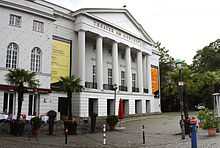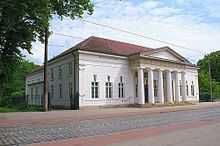Viertel (Bremen)
Viertel (literally "quarter"), consisting of the subdistricts Ostertor and Steintor of two different administrative districts, is a centrally situated suburb of the city of Bremen in the north of Germany. It lies east of the old town between Ostertor and Steintor.[1]
History
The neighbourhood was developed from the mid-19th century until the 1930s when typical Bremen Houses (Bremer Häuser) were built in a combination of Neohistoricist, Neoclassical and Art Nouveau styles. They nevertheless fall into an attractive, harmonious environment. Construction firms designed whole stretches of the area's streets combining tall, narrow row houses with stately villas.[1] Until 1973, the area around Ostertor fells into a sorry state as there were plans to build a motorway along the Mozartstraße but after sustained protests, the plans were finally shelved. Thereafter the old facades were restored, making the district one of Bremen's most presentable and lively. New buildings are designed so that they fit into their historic surroundings and the local colour scheme.[2]
Landmarks
The Viertel embraces Bremen's cultural mile with the city's main theatre, and three museums.[3] The Theater am Goetheplatz, completed in 1913 in the Neoclassical style, presents productions of musicals, opera and drama.[4] The art museum Kunsthalle Bremen was built in 1849, enlarged in 1902 and further expanded in 2011. It houses European paintings and sculptures from the Middle Ages to the present day as well as a new media section.[5] The Gerhard Marcks House from 1825 is a museum inspired by the sculptor Gerhard Marcks exhibiting contemporary sculpture.[6] Forming a pair with the Wilhelm Wagenfeld House standing opposite, it hosts design exhibitions inspired by Wilhelm Wagenfeld, noted for his household object designs.[7]
-

Theater am Goetheplatz
-

Kunsthalle Bremen
-

The Gerhard Marcks House paired with the Wilhelm Wagenfeld House
-

Wilhelm Wagenfeld House
Another interesting landmark in the area is "Wilhelm Holtorf Kolonialwaren von 1874", an old grocer's shop on Ostertorsteinweg which was renovated in the Art Nouveau style in 1903 and is now a listed building.[8]
The Viertel district today
Today the district is known for its shops, cafés and restaurants. In addition to the cultural mile, locals also appreciate the shopping mile on Ostertorsteinweg stretching from the theatre to St. Jürgen Straße. There are no department stores here, only small shops and boutiques offering everything imaginable.[2]
References
- ↑ 1.0 1.1 "Das Viertel" (in German). dasviertel.de. Retrieved 20 January 2014.
- ↑ 2.0 2.1 "Ostetor" (in German). Bremen-freizeit.de. Retrieved 20 January 2014.
- ↑ "The Viertel ('quarter')". Bremen-tourism.de. Retrieved 20 January 2014.
- ↑ Thomas Kuzaj (2 July 2013). "Säulen und Avantgarde" (in German). kreiszeitung.de. Retrieved 13 January 2014.
- ↑ "Kunsthalle Bremen". euromuse.net. Retrieved 20 January 2014.
- ↑ "Gerhard-Marcks-Haus" (in German). Museen in Bremen. Retrieved 20 January 2014.
- ↑ David Galloway (30 May 1998). "City Has Rejuvenated the Focke and Kunsthalle : Bremen Brushes Up Its Museums". New York Times. Retrieved 18 December 2013.
- ↑ "Wilhelm Holtorf Colonialwaren von 1874". Bremen-freizeit.de. Retrieved 20 January 2014.